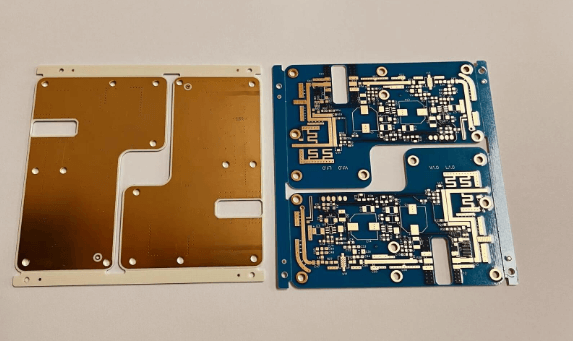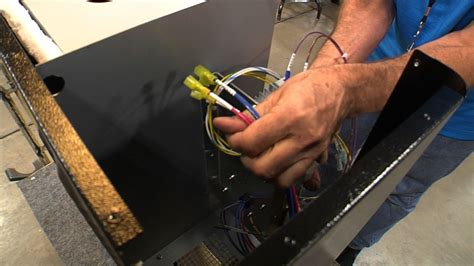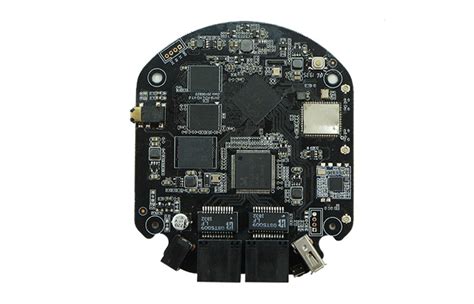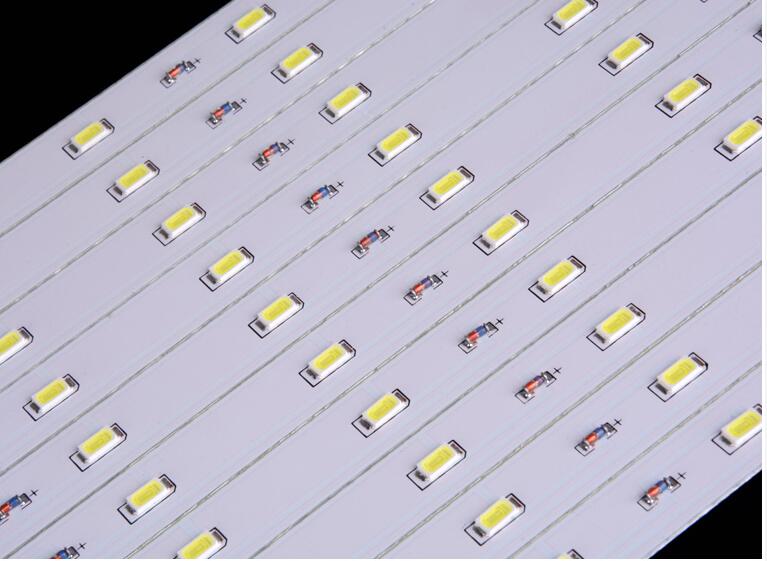Rogers ro4003c pcb
Advantages Of Using Rogers RO4003C PCB In High-Frequency Applications
Rogers RO4003C PCB is a high-performance material widely recognized for its exceptional properties in high-frequency applications.
One of the primary advantages of using Rogers RO4003C PCB is its low dielectric constant, which is crucial for maintaining signal integrity in high-frequency circuits.
This low dielectric constant ensures minimal signal loss and distortion, thereby enhancing the overall performance of the electronic device. Additionally, the material exhibits a stable dielectric constant over a wide range of frequencies, which is essential for applications that require consistent performance across different operating conditions.
Another significant benefit of Rogers RO4003C PCB is its low dissipation factor.
The dissipation factor, or loss tangent, measures the energy lost as heat in the dielectric material. A low dissipation factor indicates that the material can efficiently transmit signals with minimal energy loss, making it ideal for high-frequency applications where power efficiency is paramount. This characteristic is particularly beneficial in telecommunications, radar systems, and other RF (radio frequency) applications where signal clarity and strength are critical.
Moreover, Rogers RO4003C PCB offers excellent thermal management properties.
The material has a high thermal conductivity, which allows it to dissipate heat effectively. This is particularly important in high-frequency applications where components can generate significant amounts of heat. Effective thermal management ensures that the components operate within their optimal temperature range, thereby enhancing their reliability and longevity. Furthermore, the material’s thermal stability ensures that its electrical properties remain consistent even under varying thermal conditions, which is crucial for maintaining the performance of high-frequency circuits.
In addition to its electrical and thermal properties, Rogers RO4003C PCB is also known for its mechanical stability.
The material exhibits low thermal expansion, which means it undergoes minimal dimensional changes with temperature fluctuations. This property is essential for maintaining the structural integrity of the PCB and ensuring reliable performance over time. The mechanical stability of Rogers RO4003C PCB makes it suitable for applications that require precise and consistent performance, such as aerospace and defense systems.
Furthermore, Rogers RO4003C PCB is compatible with standard PCB fabrication processes, which simplifies the manufacturing process and reduces production costs.
The material can be processed using conventional methods, including standard etching and plating techniques, which makes it an attractive option for manufacturers. This compatibility also ensures that the material can be easily integrated into existing production lines, thereby minimizing disruptions and facilitating a smooth transition to high-performance PCB materials.
Additionally, Rogers RO4003C PCB offers excellent moisture resistance, which is crucial for applications exposed to harsh environmental conditions.
The material’s low moisture absorption ensures that its electrical properties remain stable even in humid environments, thereby enhancing the reliability and performance of the electronic device. This characteristic is particularly important for outdoor applications, such as base station antennas and satellite communication systems, where exposure to moisture is inevitable.
In conclusion, the advantages of using Rogers RO4003C PCB in high-frequency applications are manifold. Its low dielectric constant and dissipation factor ensure minimal signal loss and energy efficiency, while its excellent thermal management properties enhance reliability and longevity. The material’s mechanical stability and compatibility with standard fabrication processes further add to its appeal, making it a preferred choice for high-frequency applications across various industries. Additionally, its moisture resistance ensures consistent performance in challenging environmental conditions, thereby solidifying its position as a high-performance material for advanced electronic applications.

Design Tips For Optimizing Performance With Rogers RO4003C PCB
When designing printed circuit boards (PCBs) for high-frequency applications, the choice of substrate material is crucial. Rogers RO4003C is a popular choice among engineers due to its excellent electrical properties and mechanical stability. To optimize performance with Rogers RO4003C PCB, several design considerations must be taken into account.
Firstly, understanding the material properties of Rogers RO4003C is essential.
This substrate is known for its low dielectric constant (Dk) of approximately 3.38, which remains stable over a wide frequency range. This stability ensures minimal signal loss and consistent performance, making it ideal for high-frequency applications such as RF and microwave circuits. Additionally, the low dissipation factor (Df) of 0.0027 at 10 GHz further enhances signal integrity by reducing dielectric losses.
Transitioning to the layout design, it is imperative to maintain controlled impedance.
Controlled impedance is critical in high-frequency circuits to ensure signal integrity and minimize reflections. To achieve this, precise trace width and spacing must be calculated based on the dielectric constant and thickness of the RO4003C material. Utilizing impedance calculators or simulation tools can aid in determining the optimal dimensions for the traces.
Moreover, the choice of copper weight plays a significant role in the performance of the PCB.
Rogers RO4003C is compatible with various copper weights, but selecting the appropriate thickness is vital. Thicker copper can handle higher current loads, which is beneficial for power distribution networks. However, it can also introduce additional parasitic inductance, which may affect high-frequency performance. Therefore, a balance must be struck based on the specific requirements of the application.
In addition to copper weight, the surface finish of the PCB can impact signal integrity.
For high-frequency applications, smooth surface finishes such as Electroless Nickel Immersion Gold (ENIG) or immersion silver are preferred. These finishes provide a flat surface that minimizes signal loss and ensures reliable solderability. Avoiding rough finishes like hot air solder leveling (HASL) can prevent unwanted signal attenuation and impedance variations.
Thermal management is another critical aspect to consider when designing with Rogers RO4003C.
High-frequency circuits often generate significant heat, which can affect performance and reliability. Implementing thermal vias and heat sinks can help dissipate heat effectively. Additionally, using materials with high thermal conductivity for the PCB stack-up can further enhance thermal management.
Furthermore, the placement of components and routing of traces should be carefully planned to minimize electromagnetic interference (EMI).
High-frequency signals are susceptible to EMI, which can degrade performance. Shielding critical areas and maintaining adequate spacing between high-speed traces and noisy components can mitigate EMI issues. Ground planes should be used extensively to provide a low-impedance return path for signals and reduce noise coupling.
Lastly, it is essential to consider the manufacturing tolerances and capabilities of the PCB fabricator. Rogers RO4003C requires precise processing techniques to maintain its electrical properties. Collaborating with experienced fabricators who are familiar with this material can ensure that the final product meets the desired specifications. Providing detailed design files and clear communication with the fabricator can help avoid potential issues during production.
In conclusion, optimizing performance with Rogers RO4003C PCB involves a comprehensive understanding of the material properties and careful consideration of various design aspects. By focusing on controlled impedance, appropriate copper weight, smooth surface finishes, effective thermal management, EMI mitigation, and manufacturing tolerances, engineers can achieve high-performance PCBs suitable for demanding high-frequency applications.

Comparing Rogers RO4003C PCB To Other High-Frequency Materials
When comparing Rogers RO4003C PCB to other high-frequency materials, it is essential to consider various factors that influence the performance and suitability of these materials for specific applications. Rogers RO4003C is a widely recognized high-frequency laminate known for its excellent electrical properties, mechanical stability, and ease of fabrication. However, to fully appreciate its advantages, it is necessary to juxtapose it with other high-frequency materials available in the market.
One of the primary attributes of Rogers RO4003C is its low dielectric constant (Dk) of 3.38, which remains stable over a wide frequency range.
This stability is crucial for maintaining signal integrity in high-frequency applications, such as RF and microwave circuits. In contrast, other materials like FR-4, commonly used in standard PCBs, have a higher and less stable dielectric constant, making them less suitable for high-frequency applications. The consistency of the dielectric constant in RO4003C ensures minimal signal loss and distortion, which is paramount in high-speed communication systems.
Moreover, the dissipation factor (Df) of Rogers RO4003C is notably low, typically around 0.0027 at 10 GHz.
This low dissipation factor translates to reduced signal attenuation, which is a significant advantage over other materials with higher Df values. For instance, materials like PTFE (Polytetrafluoroethylene) laminates, while also used in high-frequency applications, often exhibit higher dissipation factors, leading to greater signal loss. Therefore, RO4003C’s low dissipation factor makes it a preferred choice for applications requiring minimal signal degradation.
In addition to electrical properties, mechanical stability is another critical aspect where Rogers RO4003C excels.
The material exhibits excellent dimensional stability, which is essential for maintaining the integrity of the PCB during the manufacturing process and in operational environments. Compared to other high-frequency materials, such as ceramic-filled PTFE composites, RO4003C offers a more balanced combination of mechanical robustness and ease of processing. This balance simplifies the fabrication process, reducing costs and improving yield rates.
Furthermore, the thermal properties of Rogers RO4003C are noteworthy.
With a glass transition temperature (Tg) of over 280°C, it can withstand higher processing temperatures without significant degradation. This high Tg is advantageous when compared to other materials like FR-4, which typically have lower Tg values and may not perform as well under elevated temperatures. The thermal stability of RO4003C ensures reliable performance in demanding applications, such as aerospace and defense, where temperature fluctuations are common.
Another aspect to consider is the cost-effectiveness of Rogers RO4003C.
While it may be more expensive than standard materials like FR-4, it is generally more affordable than some high-end alternatives like ceramic-filled PTFE laminates. This cost advantage, combined with its superior electrical and mechanical properties, makes RO4003C an attractive option for many high-frequency applications.
In conclusion, when comparing Rogers RO4003C PCB to other high-frequency materials, it becomes evident that RO4003C offers a unique combination of low dielectric constant, low dissipation factor, excellent mechanical stability, and high thermal resistance. These attributes make it a superior choice for high-frequency applications, providing a balance of performance and cost-effectiveness that is difficult to match. While other materials may excel in specific areas, the overall advantages of Rogers RO4003C make it a preferred option for engineers and designers seeking reliable and efficient solutions for their high-frequency PCB needs.

Manufacturing Challenges And Solutions For Rogers RO4003C PCB
Rogers RO4003C is a high-frequency laminate material widely used in the manufacturing of printed circuit boards (PCBs) for applications requiring superior electrical performance and reliability. However, the manufacturing of PCBs using Rogers RO4003C presents several challenges that must be addressed to ensure optimal performance and durability. Understanding these challenges and implementing effective solutions is crucial for manufacturers aiming to leverage the benefits of this advanced material.
One of the primary challenges in manufacturing Rogers RO4003C PCBs is the material’s sensitivity to thermal stress
Unlike traditional FR-4 materials, RO4003C has a lower coefficient of thermal expansion (CTE), which can lead to issues such as delamination and warping during the soldering process. To mitigate these risks, manufacturers must carefully control the thermal profiles during reflow soldering. This involves optimizing the heating and cooling rates to minimize thermal shock and ensure uniform temperature distribution across the PCB. Additionally, pre-baking the laminates before processing can help reduce moisture content, further decreasing the likelihood of delamination.
Another significant challenge is the material’s mechanical properties, which differ from those of conventional PCB substrates.
RO4003C is more brittle and less flexible, making it susceptible to cracking and damage during handling and assembly. To address this, manufacturers should implement stringent handling protocols, including the use of soft gloves and anti-static mats to prevent mechanical stress. Moreover, designing the PCB layout with rounded corners and avoiding sharp edges can help distribute mechanical stress more evenly, reducing the risk of fractures.
The drilling process also poses challenges when working with Rogers RO4003C.
The material’s hardness can cause rapid tool wear, leading to burr formation and poor hole quality. To overcome this, manufacturers should use high-quality, diamond-coated drill bits and regularly monitor tool wear to ensure consistent performance. Additionally, optimizing drilling parameters such as spindle speed and feed rate can help achieve cleaner holes and extend tool life. Implementing a multi-step drilling process, where a smaller pilot hole is drilled before the final hole, can also improve hole quality and reduce stress on the material.
Adhesion between the RO4003C laminate and the copper foil is another critical factor that can impact the performance of the PCB.
Poor adhesion can lead to issues such as copper lift and delamination, especially in high-frequency applications where signal integrity is paramount. To enhance adhesion, manufacturers should ensure that the copper surface is thoroughly cleaned and roughened before lamination. This can be achieved through chemical treatments or mechanical abrasion techniques. Additionally, using a high-quality bonding film or adhesive can further improve the bond strength between the copper and the laminate.
Finally, the etching process for Rogers RO4003C PCBs requires careful control to achieve precise and consistent results.
The material’s unique properties can affect the etching rate, leading to variations in trace width and spacing. To address this, manufacturers should use a controlled etching process with precise monitoring of etchant concentration, temperature, and agitation. Implementing automated etching systems with real-time feedback can help maintain consistent etching quality and reduce the risk of defects.
In conclusion, while the manufacturing of Rogers RO4003C PCBs presents several challenges, these can be effectively managed through careful process control and optimization. By addressing thermal stress, mechanical properties, drilling quality, adhesion, and etching precision, manufacturers can produce high-performance PCBs that leverage the advanced properties of RO4003C laminates. This ensures that the final products meet the stringent requirements of high-frequency applications, providing reliable and efficient performance in demanding environments.





